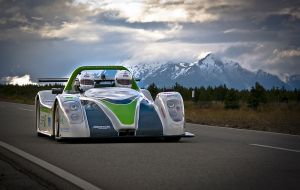MercoPress. South Atlantic News Agency
Alaska to Ushuaia in an electric car developed at the Imperial College London
 The SRZero will be on display next week in Buenos Aires
The SRZero will be on display next week in Buenos Aires An electric sports car developed by European engineers has finished a remarkable 26.000 kilometres road trip on the Panamerican Highway, travelling from near the Arctic Circle in Alaska to the world's southernmost city, Ushuaia without a single blast of carbon dioxide emissions.
Developed by (British, Dutch and German) engineers from Imperial College London, the SRZero ran on lithium iron phosphate batteries powering two electric motors with a peak output of 400 horsepower. The average distance covered per day was 290 kilometres.
The SRZero is scheduled to be exhibited at Buenos Aires obelisk beginning next week.
Powering up was a joy at times, the team said - such as in Chena Hot Springs, Alaska, where they started their trip on July 4 after charging the batteries using geothermal energy.
“The SRZero was literally being charged from energy taken straight out of the earth with absolutely zero CO2 emissions,” Alex Schey, a mechanical engineer who organised the trip, wrote in his blog that day.
Finding places to plug in along the way became a major challenge as the team passed through 14 countries in 70 days of driving.
But every time the driver hit the brakes - and there was plenty of that as the team made its way through the Rocky Mountains, Mexico and Central America and then through South America - the car recovered kinetic energy, extending its capacity to drive as much as six hours and more than 400 kilometres on a single charge.
This was no clunky science project - all that horsepower enabled the car to reach 100 kph in just seven seconds and reach top controlled speeds of 200kph, the team said.
It pulled into the city of Ushuaia, in Tierra del Fuego, on Tuesday afternoon.
“The success of efforts like this should motivate us to follow this road that we believe is as possible as it is necessary - that of searching for progress for our societies without putting at risk the environment,” the governor of Argentina's Tierra del Fuego province, Fabiana Ros, said as she greeted the team.
Andy Hadland, the team's spokesman, said he hoped the trip would change the image of electric cars and inspire young people to become engineers and develop their own projects.
“We’re proud of having reached our goal and having developed this initiative”, said Toby Schulz. “Many people said we wouldn’t make it to Ushuaia but we did”•
You can read more about their trip blog by http://www.racinggreenendurance.com/




Top Comments
Disclaimer & comment rules-

-

-

Read all comments“This was no clunky science project - all that horsepower enabled the car to reach 100 kph in just seven seconds and reach top controlled speeds of 200kph, the team said.” just, wow! I'll be there to see this super car ;)
Nov 18th, 2010 - 11:08 pm 0Does sound like an amazing car, No emmissions?
Nov 18th, 2010 - 11:50 pm 0The world needs more of this type of technology.
I agree, this one is coming out “The Green Car of the Year award”, A fully charged battery and full tank of gas will allow the Volt to travel 310 miles.
Nov 19th, 2010 - 01:27 am 0http://www.egmcartech.com/2010/11/18/2010-la-chevrolet-volt-wins-2011-green-car-of-the-year/
Good news for South America, Chile and Argentina are the largest producer of lithium, used in the batteries and Bolivia, I believe have the largest deposit of that mineral.
Commenting for this story is now closed.
If you have a Facebook account, become a fan and comment on our Facebook Page!